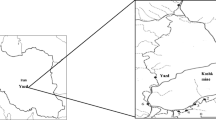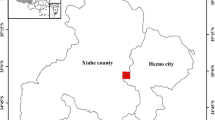Abstract
The concentrations of uranium, thorium, barium, nickel, strontium and lead in the samples of the tailings and plant species collected from a uranium mill tailings repository in South China were analyzed. Then, the removal capability of a plant for a target element was assessed. It was found that Phragmites australis had the greatest removal capabilities for uranium (820 μg), thorium (103 μg) and lead (1,870 μg). Miscanthus floridulus had the greatest removal capabilities for barium (3,730 μg) and nickel (667 μg), and Parthenocissus quinquefolia had the greatest removal capability for strontium (3,920 μg). In this study, a novel coefficient, termed as phytoremediation factor (PF), was proposed, for the first time, to assess the potential of a plant to be used in phytoremediation of a target element contaminated soil. Phragmites australis has the highest PFs for uranium (16.6), thorium (8.68), barium (10.0) and lead (10.5). Miscanthus floridulus has the highest PF for Ni (25.0). Broussonetia papyrifera and Parthenocissus quinquefolia have the relatively high PFs for strontium (28.1 and 25.4, respectively). On the basis of the definition for a hyperaccumulator, only Cyperus iria and Parthenocissus quinquefolia satisfied the criteria for hyperaccumulator of uranium (36.4 μg/g) and strontium (190 μg/g), and could be the candidates for phytoremediation of uranium and strontium contaminated soils. The results show that the PF has advantage over the hyperaccumulator in reflecting the removal capabilities of a plant for a target element, and is more adequate for assessing the potential of a plant to be used in phytoremediation than conventional method.
Similar content being viewed by others
References
AbdEl-Sabour MF (2007) Remediation and bioremediation of uranium contaminated soils. EJEAFChem 6:2009–2023
Baker AJM, Brooks RR (1989) Terrestrial higher plants which hyperaccumulate metallic-a review of their distribution, ecology and phytochemistry. Biorecovery 1:81–126
Blanco Rodríguez PB, Vera Tome F, Lozano JC (2002) About the assumption of linearity in soil-to-plant transfer factors for uranium and thorium isotopes and 226Ra. Sci Total Environ 284:167–175
Chen SB, Zhu YG, Hu QH (2005) Soil to plant transfer of 238U, 226Ra and 232Th on a uranium mining-impacted soil from southeastern China. J Environ Radioact 82:223–236
Florijn PJ DE, Knecht JA, Van Beusichem ML (1993) Phytochelatin concentrations and binding state of Cd in roots of maize genotypes in shoot/root Cd partitioning. J Plant Physiol 142:537–542
Frostick A, BollhÖfer A, Parry D, Munksgaard N, Evans K (2008) Radioactive and radiogenic isotopes in sediments from Cooper Creek, Western Arnhem Land. J Environ Radioact 99:468–482
Gramatica P, Battaini F, Giani E, Papa E, Jones RJA, Preatoni D, Cenci RM (2006) Analysis of mosses and soils for quantifying heavy metal concentrations in Sicily: a multivariate and spatial analytical approach. Environ Sci Pollut Res 13:28–36
Huang JW, Blaylock MJ, Kapulnik Y, Ensley BD (1998) Phytoremediation of uranium-contaminated soils: role of organic acids in triggering uranium hyperaccumulation in plants. Environ Sci Technol 32:2004–2008
Jiang QQ, Singh BR (1994) Effect of different forms and sources of arsenic on crop yield and arsenic concentration. Water Air Soil Pollut 74:321–343
Landa ER (2004) Uranium mill tailings: nuclear waste and natural laboratory for geochemical and radioecological investigations. J Environ Radioact 77:1–27
Liang Q, **g H, Conrad Gregoire D (2000) Determination of trace elements in granites by inductively coupled plasma mass spectrometry. Talanta 51:507–513
NY/T 1121 (2006) The standard for soil testing, published by ministry of agriculture of the people’s republic of China (in Chinese)
Robinson BH, Brooks RR, Howes AW, Kirkman JH, Gregg PEH (1997) The potential of the high-biomass nickel hyperaccumulator Berkheya coddii for phytoremediation and phytomining. J Geochem Explor 60:115–126
Shahandeh H, Hossner LR (2002) Role of soil properties in phytoaccumulation of uranium. Water Air Soil Pollut 141:165–180
Tu C, Ma LQ, Bondada B (2002) Arsenic accumulation in the hyperaccumulator Chinese brake and its utilization potential for phytoremediation. J Environ Q 31:1671–1675
Verma VK, Singh YP, Rai JPN (2007) Biogas production from plant biomass used for phytoremediation of industrial wastes. Bioresour Technol 98:1664–1669
Whicker FW, Hinton TG, Orlandini KA, Clark SB (1999) Uptake of natural and anthropogenic actinides in vegetable crops grown on a contaminated lake bed. J Environ Radioact 45:1–12
Acknowledgments
This research is supported by Scientific Research Foundation of Education Department (grant No. 10A103 and grant No. 10C1134) and Science and Technology Department (grant No. 2010GK2025) of Hunan Province.
Author information
Authors and Affiliations
Corresponding author
Rights and permissions
About this article
Cite this article
Li, Gy., Hu, N., Ding, Dx. et al. Screening of Plant Species for Phytoremediation of Uranium, Thorium, Barium, Nickel, Strontium and Lead Contaminated Soils from a Uranium Mill Tailings Repository in South China. Bull Environ Contam Toxicol 86, 646–652 (2011). https://doi.org/10.1007/s00128-011-0291-2
Received:
Accepted:
Published:
Issue Date:
DOI: https://doi.org/10.1007/s00128-011-0291-2




